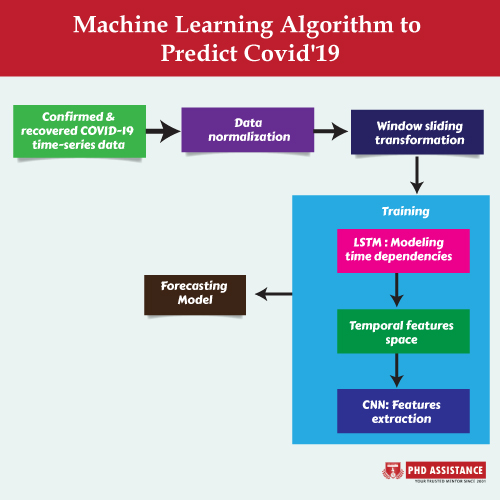Dissertation on Computer Science: Machine Learning Algorithm to Predict Covid’19
Introduction
Artificial intelligence and data science play a vital role in the health-care business in this era of automation. Medical practitioners may simply manage their duties and patient care since these technologies is so well-connected. Dependence on automated systems such as AI has increased in healthcare services. Diagnostic procedures and treatments are now being greatly assisted by Machine Learning. ML can identify illness and viral infections more precisely, allowing patients’ ailments to be identified earlier, severe phases of diseases to be avoided, and fewer people to be treated.
Not just in medicine, but also in all other fields, MLs play a great role. In the healthcare, both cutting down time, and accurate diagnosis are life saving, and MLs enable that possible. If the therapy has a high incidence of mistake, it may result in several fatalities. As a result, scientists have begun to use artificial intelligence applications in medical therapy. The work is difficult because the researchers must select the appropriate tool: it is a life or death situation.
PhD Assistance develop ML algorithms using Python, Hadoop framework and many more to both secure access control in Networking platforms. Hiring our experts, you are assured with quality and on-time delivery.
ML sets a new standard in the sphere of health care with this work. Large datasets are analyzed and predicted using machine learning techniques. These machine learning methods are utilized to categorize samples into treatment groups and detect illness signs. Hospitals may use machine learning to keep administrative operations running smoothly and cure infectious diseases.
ML methods have previously been used to treat cancer, pneumonia, diabetes, Parkinson’s disease, arthritis, neuromuscular disorders, and a variety of other diseases; in prediction and forecasting, they provide more than 90% accuracy.

Machine Learning and Covid-19
COVID-19 is a terrible pandemic illness that has claimed the lives of countless individuals all over the world. This virus has no known therapy. Based on symptoms described by the WHO and CDC, machine learning techniques have been applied to predict whether individuals are infected with the virus. On the basis of x-ray pictures, ML is also used to diagnose the illness. Patients’ chest scans, for example, can be utilized to determine whether they are infected with COVID-19.Furthermore, ML can detect social distance; with this technique, we can keep ourselves secure from COVID-19.
PhD Assistance experts has experience in handling dissertation and assignment in computer science research with assured 2:1 distinction. Talk to Experts Now
Prediction and Forecasting Strategies
To anticipate and forecast future occurrences, several machine learning approaches are utilized. Support vector machines, linear regression, logistic regression, naive Bayes, decision trees (random forest and ETC), K-nearest neighbor, and neural networks are some of the machine learning approaches used for prediction (multilayer perceptron).
Similarly, the naive approach, moving average, simple exponential smoothing, Holt’s linear trend model, Holt-Winters model, Seasonal Autoregressive Integrated Moving Average Exxogenous Model (SARIMAX), and Autoregressive Integrated Moving Average Model are some ML techniques used to forecast future events (ARIMA). Each approach has its own characteristics and is utilised in a different way depending on the accuracy results. Time series analysis, which is an essential element of ML, may be utilised for predicting using ML. It’s a form of univariate regression in which only one input factor (independent feature), time, is used to anticipate the target feature (dependent feature).
PhD Assistance has vast experience in developing dissertation research topics for students pursuing the UK dissertation in computer science. Order Now
Forecasting
Benefits of ML It’s used to predict future event values, and it’s very useful for predicting the occurrence of respiratory illnesses like COVID-19. Positive instances are rising on a daily basis, thus it’s important to estimate if the current ratio of increasing cases will continue based on previous data. It is beneficial to the government because, based on the prognosis, it can organize resources to prevent illness transmission and act in the future so that the infection’s growth rate slows and fewer people are affected. Forecast values cannot be guaranteed because they are entirely dependent on historical patterns. This projected approximation of occurrences, on the other hand, may aid authorities in assessing future resource planning in the case of a pandemic, such as COVID-19.
Conclusion
The COVID-19 epidemic has spread across the world. Scientists have made every attempt to discover a cure; according to statements from the US and India, several vaccinations have been developed and are now being tested. Scientists have been using computers to make early predictions for a long time. ML is being used in a lot of studies to fight COVID-19. COVID-19 has resulted in a large number of fatalities in several nations. If more datasets are provided, it is thought that the ARIMA model’s performance can be enhanced or that the model can provide more accurate data.
Reference
- Confirmed cases of Covid 19. Available from: https://www.covid19india.org/.
- David J Cennimo Discusses Coronavirus Disease 2019 (COVID 19). Available from: https://emedicine.medscape.com/article/2500114-overview.
- Quinlan R. Morgan Kaufmann Publishers; San Mateo, CA: 2014. C4.5: Programs for Machine Learning. [Google Scholar]
- Turaiki I., Alshahrani M., Almutairi T. Building predictive models for MERS-CoV infections using data mining techniques. J. Infect. Public Health. 2016;09:744–748. [PMC free article] [PubMed] [Google Scholar]
- Chouhan V., Singh S.K., Khamparia A., Gupta D., Tiwari P., Moreira C., Damaševičius R., De Albuquerque V.H.C. A Novel transfer learning based approach for pneumonia detection in chest X-ray images. Appl. Sci. 2020;10:559. [Google Scholar]
- Sreeja S., Bhavya L., Swamynath S., Dhanuja R. Chest x-ray pneumonia prediction using machine learning algorithms. Int. J. Res. Appl. Sci. Eng. Technol. 2019;07(04):3227–3230. [Google Scholar]
- Kose U., Guraksin G.E., Deperlioglu O. 2015. Diabetes Determination via Vortex Optimization Algorithm Based Support Vector Machines: Medical Technologies National Conference; pp. 1–4. [Google Scholar]
- Sharmila S., Dharuman C., Venkatesan P. Disease classification using machine learning algorithms – a comparative study. Int. J. Pure Appl. Math. 2017;114(06):1–10. [Google Scholar]
- Shirsath S.S. Disease prediction using machine learning over big data. Int. J. Innov. Res. Sci. 2018;07(06):6752–6757. [Google Scholar]
- Er O., Yumusak N., Temurtas F. Chest diseases diagnosis using artificial neural networks. Expert Syst. Appl. 2010;37(12):7648–7655. [Google Scholar]
- Yang Z.F., Zeng Z.Q., Wang K. Modified SEIR and AI prediction of the epidemics trend of COVID-19 in China under public health interventions. J. Thorac. Dis. 2020;12(3):165–174
 Previous Post
Previous Post Next Post
Next Post
